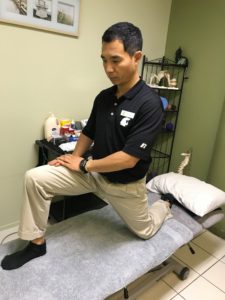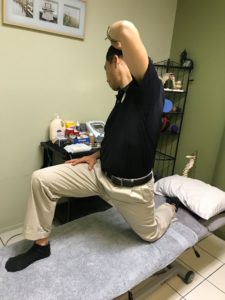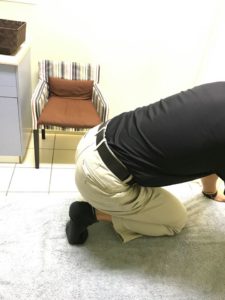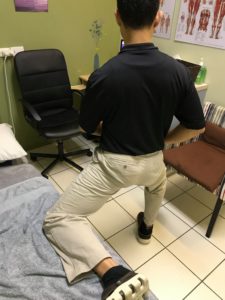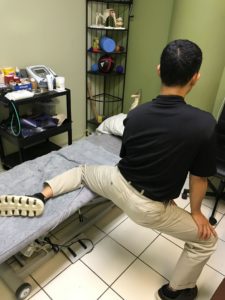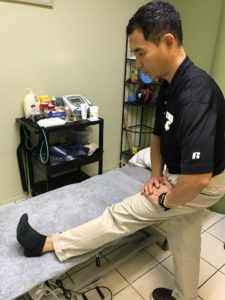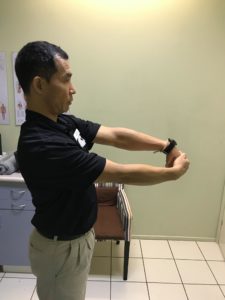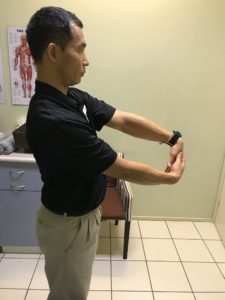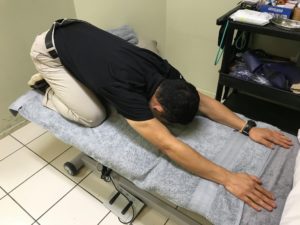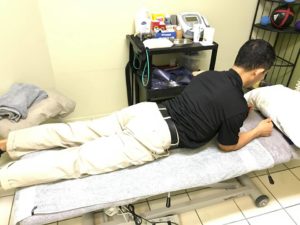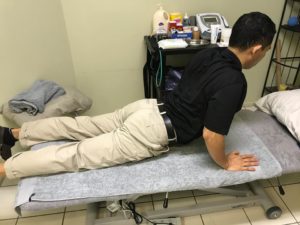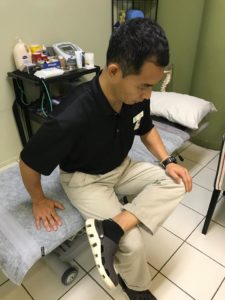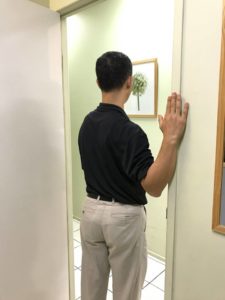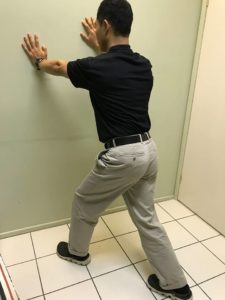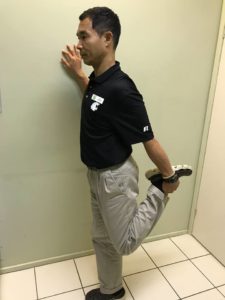Notice Board
Common Stretches List
Hip flexor stretch:
A simple stretch for the front of the hip. A common tight spot for runners.
Procedure: Kneeling at the side you stretching as per photo. Gradually shifting your body forward onto the front foot and feel the stretch at the front of stretching hip. Hold the stretch for 20 seconds then repeat it doing three times. Gradually push a bit more to get a stronger stretch.
Variations: For even stronger stretch, you can add side bending of body away from the stretching side as per photos.
Tibialis anterior stretch:
A simple stretch for the shin – front of leg. It tends to be tight with runner which can be a contribution to shin-splints.
Procedure: In kneeling position (preferably on carpet), pointing toes down as shown in photo and slowly sit your buttock onto your heels. Feel the stretch along the front of your legs then hold for 20 seconds. Lift you buttock up and repeat the stretch again. Do three sets. You can do one side at a time.
Variations: For people having trouble to kneel due to restricted knee bending, the stretch can be done in long sitting with knee slight bend or straight. A helper is needed to assist pushing down the foot to achieve the stretch at the front of your leg. Hold stretch as above. Self massage is also beneficial.
Plantar fascia stretch:
A simple stretch for the underneath of foot (Foot intrinsic muscles and plantar fascia)
Procedure: In kneeling position (preferably on carpet), tuck toes underneath as shown in photo and slowly sit your buttock onto your heels. Feel the stretch under the foot then hold for 20 seconds. Move your buttock away and repeat the stretch again. Do three sets.
Variations: For people having trouble to bend the knees in kneeling position, the stretch can be done in standing. Facing a wall and place your toes (stretching side) against the wall. You then move your leg forward over ankle and feel the stretch underneath the foot. Hold and repeat as above.
For people suffering plantar fasciitis, it would be good to soak your feet in hot water (comfortable warm) for 10 minutes prior doing the stretch. Better do the stretch at least three times per day.
Thoracic extension stretch:
A great simple stretch for the upper back.
Procedure: By placing a firmly rolled up towel, slight bigger than your fist) across your upper back (roughly at the level of your mid shoulder blade) and lie flat on carpet or some where firm and comfortable surface with arms and legs stretch our as per photo shown. Hold the position for 10 seconds. Then move the rolled towel a bit lower and repeat the stretch again. middle Keep moving the rolled towel a bit lower each time until just below the lowest point of shoulder blade. Generally it would be about four to five positions in total. Good to do it before going to bed at night and even first thing in the morning.
Variations: For people with very stiff/sore upper back, two pillows stacking together can be used instead of the rolled towel for comfort. Once the back gradually feeling easier after two~three days, then can try the rolled towel.
Adductor muscles stretch:
A great simple stretch for the inner thigh muscles. It is a common tight muscle that people do not stretch regularly.
Procedure: By placing your leg on the bed as shown in the photo, keeping your thigh out inline with your body plane. Then slowly lower your other leg to allow your stretching leg to be out further. Feel the stretch at the inner thigh region until you get a definite stretch feel and hold the position for 20 seconds then repeat twice more. Try to go a bit further down as able. The height of object for placing the leg depends on the tightness of your adductor muscles and your knee condition (if you having trouble to squat down).
Variations: As adductor muscles have different parts, also repeat the stretch mentioned with knee straight as per photo shown.
Hamstring stretch:
A great simple stretch for the back of thigh, especially for people involving in field sports, running and cycling.
Procedure: By placing your heel on a stool, a bed or a chair, then keep your back straight and knee straight at the stretching side, slowly bending forward at the hip until you feel the stretch at the back of thigh (hamstring muscle). Hold 20 seconds and repeat three times, try to go a bit further each time as able.
Variation: Everyone has different hamstring tightness. When you start to do hamstring stretch, and you think are tight, then better start with lower heel placement, on a low stool or just on the floor, to do your hamstring stretch. As you get freer, then you can place heel on higher level to stretch the hamstring out more.
Wrist extensor and flexor stretches:
Great stretches for the elbow/forearm/wrist if you tends to use your hands a lot of for work and for racquet sports
Procedure: Keep your elbow straight, using opposite hand to bend the wrist up (palm facing away) and down (palm facing toward), holding each position for 20 seconds, repeat twice.
Variation: When bending the wrist down (stretching wrist extensor muscles), there are two ways with hand opened and hand in fist, which will stretch different parts of forearm extensor muscles. With the bending wrist up one (stretching wrist flexor muscles), it can be done with stronger stretch by placing your palms on the bed/table as per photo, lean your body over them to achieve the stretch.
Child’s pose stretch:
A great stretch for the back and shoulder
Procedure: Kneeling on the bed or a mat with toes pointing down and knees relative next to each other. Sit your buttock onto your heels then bend your body forward with hands on the bed reaching forward. You would feel the stretch along your back and along the outside part of your shoulder region. Hold position for 20 seconds then have body upright then repeat the stretch three times.
Key points: If you have stiff knees with limited bending, you can place a pillow between legs and thighs for you to sit on which will reduce the amount of knee bending. Adjust the pillow height as needed to accommodate the knee bending.
Cat curl stretch:
A great stretch for the back.
Procedures: Onto your hands and knees (preferably on carpet, otherwise use a soft cushion to put underneath of knees if having sore knees), then moving the middle of your body, roughly at top part of abdomen as the centre of movements, up (feeling like stretching out the whole back muscles) while your head looking down then sink the body down while head looking up. Hold each position 10 seconds, repeat five times. Do more as needed. Twice per day is good.
Key points: Your hands and knees are in position without moving. You are actually curving your body up and down.
Back extension in lying:
A great stretch for the lower back joint stiffness and disc bulging type of issue.
Procedures: Lie flat on your stomach. Place your hands at chest level on the bed. Push your upper body up with the whole body relax. This will create a curve in your lower back region. Push yourself to a level you comfortable with experiencing some tension in the lower back region. Hold the position for 10 seconds while you are breathing normally. You will feel more tension at the lower back region as you breath out each time. Then relax back to flat position then push up again to repeat the process. Do 5 repetitions each time. Twice per day is good.
Key points: For people with lower back pain, your movement might not be flexible. Therefore, do to the point you comfortably without going into a lot of pain. As per photo, you can just go to the lower level to start with by resting on elbows. Then you can go a bit higher gradually by supporting with your arms, until you can get your arm straight.
Alternative: You can do it in standing during the day by placing both hands at the back outside area of your lower back with your feet comfortably apart. Slowly bending your body back to arch your lower back. Bend to the point you comfortably and gradually go further each time as you repeat the process 5 times.
Lower back rotation:
A simple effective stretch for the lower back/buttock region.
Procedure: Lying on back. Bend one knee up to make 90 degrees at the hip. Use the opposite hand to pull the thigh across the body. Gradually and go as far as possible. Feel the stretch behind the buttock and lower back region. Hold for 20 seconds then change side. Repeat three times each and gradually go a bit further each time. Good to do it twice per day, first thing in the morning and last thing at night.
Key points: If you are experience pain in the back or in the groin area, just pull leg to the point just touching the pain and gradually work into it with each repetition.
Alternatives: If difficult to pull leg across yourself, please ask someone to perform it for you slowly. Sometimes you can just change the angle at the hip a little bit to see the tension difference of the back and stretch the tighter position.
Piriformis stretch:
A great stretch for the buttock and people with lower back issue as relieve stress on sciatic nerve
Procedure: In sitting position, put the stretching leg over the other thigh as per photo. Keep the lower back straight. Push the thigh downward to feel stretch around the hip region (usually behind and at the side of hip). Hold the stretch for 20~30 seconds. Repeat twice for each side. Do two to three times per day. If getting easier, Keep back straight and bend forward at the hip, then the stretching is stronger.
Key points: Push down at thigh region instead at knee, as it can feel uncomfortable if you have knee issue.
Alternatives: If you are quite tight, you will find it difficult to keep the back straight while doing this stretch, then it is fine to lean back into the back rest of the chair to perform the stretch.
Pectoralis stretch:
An important simple stretch for the chest to minimise round shoulders.
Procedure: Have something stable (such as door frame) to lean against into. Please your hand/forearm against the door frame and then lean your body forward to feel the stretch at the front of your chest muscle. Hold for 20~30 seconds. Repeat three times for each side.
Key points: Pectoralis muscle has different fibre portions and the hand positions shown would help stretching different part of pectoralis muscle. Higher hand position stretches lower portion of pectoralis. Make sure you do not apply any force with your hand. Hand just stuck against the door frame. Moving body forward to get the stretch. Sometimes, can turn body away from the stretching arm at the same time to get a stronger stretch.
Alternatives: If you have restriction with your shoulder movements, you can just pull arms back to open up the chest without using the door frame to start with.
Calf stretches:
An important stretch for the legs, especially after been on your feet, like running.
Procedure: Have something stable to lean into, such as wall, or fence. Place one foot forward and the other one back. The stretching calf at the back. Leaning forward to put weight onto the front foot and feel the stretch in the calf of the back leg. Hold for 20~30 seconds. Repeat three times for each side.
Key points: Make sure feet are flat on the floor, do not lift the heel when you are stretching. Both feet are pointing forward. There are two variations, one with knee straight (Gastrocnemius muscle -> upper half of calf) and the other with knee bend Soleus muscle -> lower half of calf).
Alternatives: If you are having trouble standing, such as post calf muscle strain, you can perform the stretching by sitting in a chair or bed, and use a towel to wrap around the forefoot and pull it toward you to provide stretching on the calf muscle.
Quadriceps stretch:
An effective stretch for the front of thigh.
Procedure: One hand on something stable for balance, the other hand holding the ankle up bending the knee of the same side for the stretch. Feel the stretch at the front of thigh and gradually work into more stretch feeling. Hold for 30 seconds and repeat it three times for both sides. Preferably at least twice per day, morning and night, depending how much exercise or walking you doing on the day.
Key points: Keep knees close to each other. Keep the body upright with gentle tummy tuck to keep the pelvis level to give the quad muscle a good stretch.
Alternative: For people with restricted knee bending, can use a towel to wrap around the ankle to apply the stretch. Otherwise, can do it lying down on stomach and using towel or getting someone to apply stretch.
If you are finding muscles still tight after stretching, then you might have knots building up in muscles.
Come in for a massage to release your tight muscle tension~
You will feel more productive again at work and in sport.
Check out our Facebook page for random massage promotions~







